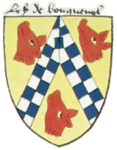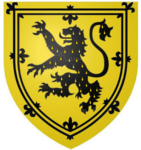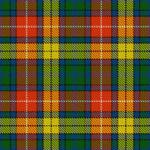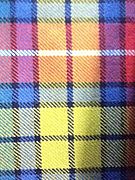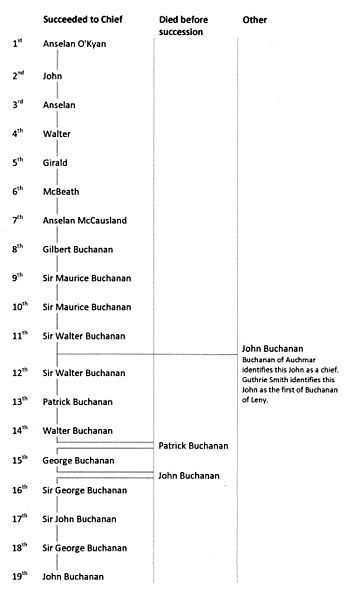Clan Buchanan facts for kids
Quick facts for kids Clan Buchanan |
|||
|---|---|---|---|
| Na Cananaich | |||

Crest: A hand coupee holding a ducal cap, or duke's cornet, proper, with two laurel branches wreathed surrounding the crest, disposed orleways proper.
|
|||
| Motto | Clarior hinc honos "The Brighter Hence the Honour" or "Henceforth forward the honour shall grow ever brighter" | ||
| War cry | Clar Innes | ||
| Profile | |||
| Region | Highlands | ||
| District | Stirling | ||
| Plant badge | Bilberry and Oak | ||
| Pipe music | "The Return of the Chief" by Richard Harris, 2016 | ||
| Chief | |||
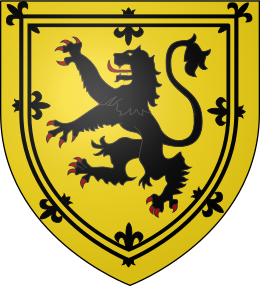 |
|||
| John Michael Baillie-Hamilton Buchanan of that Ilk | |||
| The Buchanan | |||
| Seat | Cambusmore | ||
| Historic seat | Buchanan Auld House and Clairinch island | ||
|
|||
|
|||
|
|||
|
|||
Clan Buchanan (Scottish Gaelic: Na Cananaich [nə ˈkʰanənɪç]) is a famous Highlands Scottish Clan. Its story begins around 1225 when a clergyman named Sir Absalon of Buchanan was given land on the eastern shore of Loch Lomond by the Earl of Lennox.
Contents
History of Clan Buchanan
What does the name Buchanan mean?
The name Buchanan is thought to come from Macauselan, which means "son of Anselan". It might also come from Mac a Chanonaich ("The Son of the Canon") or Buth Chanain ("house or seat of the canon").
Early Beginnings (11th-13th Centuries)
For a long time, people believed the clan started with Anselan O Kyan, an Irish king from Ulster, who supposedly arrived in Scotland in 1016. He was said to have received the lands of Buchanan from King Malcolm II for helping fight the Danes. These lands are near the village of Killearn, east of Loch Lomond.
However, recent studies, especially through DNA, show that this story is likely a myth. Clan Buchanan's roots are much older and are firmly in Scotland. DNA evidence suggests the clan was in Stirlingshire and around Loch Lomond long before the year 1000. It even shows a link to Clan Gregor from around 400 A.D., proving the clan is truly ancient Scottish.
In 1225, during the time of Malduin, Earl of Lennox, an Anselan (the third person with that name) was given the island of Clairinch. He was called 'my clergyman' by the Earl. Later, Gilbert de Buchanan, a trusted official to the Earl, had this grant confirmed in 1231 by King Alexander II. The clan's name comes from these Buchanan lands.
Fighting for Scotland (14th Century)
The Clan Buchanan played a part in the Wars of Scottish Independence. The clan supported King Robert the Bruce, helping him escape in 1306. The chief, Maurice 9th of Buchanan, refused to sign a document that would have made him loyal to the English king.
The clan and its leaders served under Malcolm the Earl of Lennox. It is believed, though not fully recorded, that they fought bravely at the famous Battle of Bannockburn in 1314, where the Scots won a major victory against the English.
Later, in 1370/71, King David II confirmed a grant of land to Maurice Buchanan. This grant gave him the land of Buchanan and Sallochy, along with the right to hold his own courts.
Battles and Changes (15th Century)
In 1421, Sir Alexander Buchanan, son of the chief, led clan members to support the French against the English in the Hundred Years' War. At the Battle of Baugé, Sir Alexander is said to have killed the Duke of Clarence, who was the second son of the English King. Sadly, Sir Alexander was later killed in another battle, the Battle of Verneuil, in 1424.
The clan's coat of arms changed a lot in the 15th century. The new design, with a black lion on a gold background and a special border, showed the clan's close ties to the Scottish royal family. The crest, a hand holding a ducal cap, celebrates Sir Alexander Buchanan's victory over the Duke of Clarence.
The 15th century also saw a fierce fight between the Buchanan's of Leny and the Clan MacLaren. During a fair, the MacLarens were surprised by the Buchanans. The battle was tough, but when the MacLaren chief saw his son fall, he became enraged. He shouted the MacLaren battle cry "Creag An Tuirc" and charged, turning the tide of the battle. The Buchanans were defeated, with only two escaping by swimming a river.
Wars and a "King" (16th Century)
During the Anglo-Scottish Wars, Clan Buchanan fought against the English. At the Battle of Flodden in 1513, the chief's eldest son, Patrick, was killed. However, Patrick had already started a family, so the clan's line continued. The clan also fought at the Battle of Pinkie Cleugh in 1547.
A famous story from this time is about John Buchanan of Arnprior, who became known as the "King of Kippen". King James V often traveled in disguise as the "Goodman of Ballengeich". One day, the King's deer were seized by John Buchanan, who was hosting a party and needed food. When the King's men protested, Buchanan famously said that if James was King in Scotland, he, Buchanan, was King in Kippen!
When King James heard this, he rode to Buchanan's house. A guard tried to stop him, but the King sent a message: "The Goodman of Ballengeich is come to feast with the King of Kippen." Buchanan immediately knew it was the King and apologized. The King, amused, forgave him and joined the feast. From then on, John Buchanan of Arnprior was known as the "King of Kippen."
Civil Wars and Losing the Estate (17th Century)
In the Wars of the Three Kingdoms, Sir George Buchanan led the Stirlingshire Regiment, which included many Buchanans. They fought for the Scottish Covenanters at the Battle of Dunbar (1650). Sir George was later captured and died in prison after the Battle of Inverkeithing. Many Buchanans were said to have died in this battle.
Some Buchanans also fought for the King, while others supported the Covenanters at the Battle of Bothwell Brig in 1679. George Buchanan (1657–1719), a successful merchant in Glasgow, was one such Covenanter. His four sons became important citizens of Glasgow and helped start The Buchanan Society charity.
Around 1681, the Buchanan family faced serious money problems. The last chief, John Buchanan, had inherited a lot of debt. Despite efforts to save it, much of the historic Buchanan Estate had to be sold. The main part of the estate, the Barony of Buchanan, was eventually sold to James Grahame, the Third Marquess of Montrose. This meant that the historic home of Clan Buchanan became the seat of Clan Graham.
Jacobite Uprisings (18th Century)
After the last chief died around 1681, Clan Buchanan didn't have a single leader for a long time. Because of this, the clan as a whole did not take part in the Jacobite uprisings of 1715 or 1745. These uprisings were attempts to bring the old Stuart royal family back to the throne.
However, individual Buchanans chose sides. Some supported the Jacobites, wanting the Stuarts to return. For example, Francis Buchanan of Arnpryor was arrested for having weapons and was executed for a serious crime against the king in 1746. Others, like Andrew Buchanan of Drumpellier, who was the Lord Provost of Glasgow, strongly supported the government. He even refused to pay money demanded by the Jacobites.
Another notable event involved Archibald Buchanan of Drummakill. After the Battle of Culloden in 1746, a Jacobite leader, William Murray, Marquis of Tullibardine, hid in Archibald's house. Archibald either accepted his surrender or captured him, turning him over to the authorities. This act was seen by many Highlanders as a betrayal of hospitality.
Clan Chiefs
The chief is the leader of the clan. Historically, the title of chief was passed down through the family, usually from father to son. The chief was often called the "Laird of Buchanan" or "Buchanan of that Ilk."
For many years, after the last recognized chief John Buchanan died in 1681, the clan did not have a clear leader. Different branches of the family tried to claim the title, but none were officially recognized by the Court of the Lord Lyon, which is Scotland's official authority for coats of arms and clan chiefs.
The New Chief
After 337 years, Clan Buchanan finally has a recognized chief again! In August 2018, the Lord Lyon King of Arms officially recognized John Michael Baillie-Hamilton Buchanan as the chief of Clan Buchanan.
He is the senior descendant of the Buchanan of Leny branch, which is a very old part of the chiefly family line. This means the clan now has a leader to represent them, perform important duties, and help guide the clan's future.
John Michael Buchanan was born in 1958 and manages the Cambusmore Estate. He is known as "The Buchanan."
Chiefs' Burial Ground
The chiefs of Clan Buchanan are traditionally buried at the Old Buchanan Parish Church. This church, called the Chapel of St Mary & St Michael, was used until about 1764. Today, nothing remains of the original chapel.
Buchanan Castles and Homes
The current home of Clan Buchanan's chief is Cambusmore. The historic main home of the clan was Buchanan Auld House in Stirlingshire. Later, Buchanan Castle was built in the 19th century to replace Buchanan Auld House, after the lands had been sold to the Grahams.
Other places connected to Clan Buchanan include:
- Craigend Castle
- Dunglass Castle (in Dunbartonshire)
- Northbar House (in Renfrewshire)
- The Buchanan Monument at Killearn
Clan Branches and Septs
The main family branches that came from the chiefly line are Leny, Arnprior, Spittal, and Auchmar.
A "sept" is a family name that is considered part of a larger clan. Many names are linked to Clan Buchanan. These names often come from early family members or places connected to the clan. Some common sept names include MacAuslan, MacWattie, Gibson, Dewar, and Morrison.
Clan Organisations
Today, there are three main groups that represent Clan Buchanan:
The Buchanan Society
The Buchanan Society was started in 1725 in Glasgow, Scotland. It is a charity that helps needy members of the clan and its recognized septs (Buchanan, McAuslan, McWattie, and Risk). The society helps young people get training for jobs or go to university. It owns the Buchanan Monument in Killearn and the island of Clairinch in Loch Lomond.
Clan Buchanan Society International
The Clan Buchanan Society International (CBSI) was formed in 1970. It is a group for people who share an interest in being a Buchanan. Members pay a yearly fee, and the society has chapters around the world, especially in the US and Oceania.
The CBSI uses a special flag called the Black Lion Banner. It has a gold background with a black lion and red claws. It also has five silver "tears" to show the clan's sadness when it didn't have a chief.
Chief's Council of Armigers
A new group called the Chief's Council of Armigers is being planned. It will help the chief lead the clan and promote its interests around the world. The council wants to encourage clan members to learn about, enjoy, and celebrate their unique Buchanan, Highland, and Scottish heritage.
See also
- Buchanan (surname) for a list of famous people named Buchanan
- Scottish clan
Images for kids
-
A romantic depiction of a clan gentleman, illustrated by R. R. McIan, from James Logan's The Clans of the Scottish Highlands, 1845.


